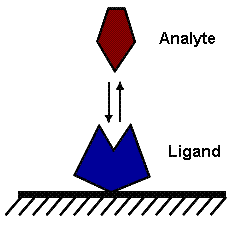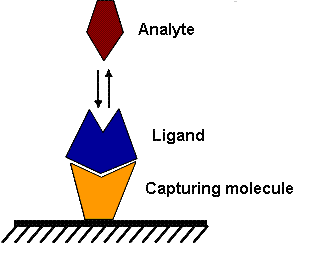Biacore X100 reference portal
Assay formats in Biacore systems
Biacore allows a number of different assay formats:
- Direct binding assays measure the amount of analyte bound directly to the detecting molecule after a fixed time of sample injection. Response enhancement or sandwich approaches can be used to amplify the response obtained and/or to increase the selectivity of the assay.
- Indirect or competition assays provide an indirect measure of analyte concentration, and are most useful for low molecular weight analytes. In the solution competition approach (also called inhibition assay), a known amount of a detecting molecule is mixed with the sample, and the amount of free detecting molecule remaining in the mixture is measured. In the surface competition method, analyte and a high molecular weight analogue (often a protein conjugate) compete for binding to a common partner on the sensor chip surface. In both competition assay formats, the response obtained is inversely related to the concentration of analyte in the sample.
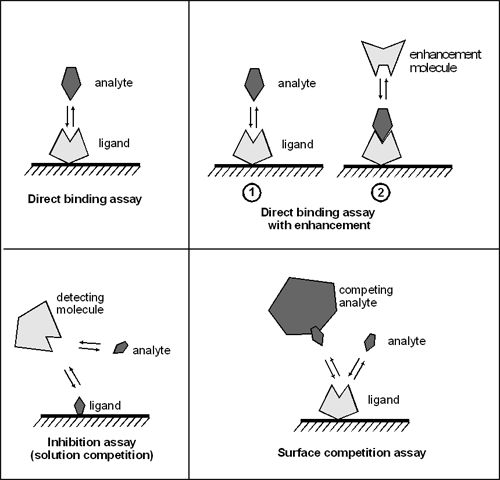
Terminology that is used in the context of concentration measurements with Biacore and presents terms specific to Biacore applications.
Biacore systems monitor the interaction between two molecules, of which one is attached to the sensor surface and the other is free in solution. The following terms are used in the context of concentration measurement with Biacore:
- The partner attached to the surface is called the ligand. Attachment may be covalent or through high affinity binding to another molecule which is in turn covalently attached to the surface. In the latter case the molecule attached to the surface is referred to as the capturing molecule. (The term “ligand” is applied here in analogy with terminology used in affinity chromatography contexts, and does not imply that the surface-attached molecule is a ligand for a cellular receptor.)
- The analyte is the molecule for which the concentration is to be measured. In direct binding assays, the analyte binds directly to the ligand. In inhibition assays, the concentration of analyte is measured indirectly through binding of an additional molecule.
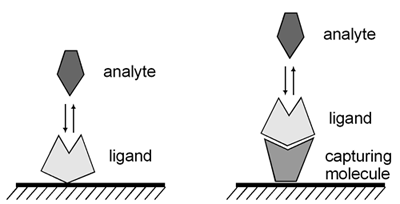
Ligand, analyte and capturing molecule in relation to the sensor surface - The detecting molecule is the molecule responsible for detecting the analyte. In direct binding assays, the detecting molecule is the same as the ligand. In inhibition assays, the detecting molecule is the molecule that binds to the ligand and generates a response which is blocked by the presence of analyte.
- Regeneration is the process of removing bound analyte from the surface after an analysis cycle without damaging the ligand, in preparation for a new cycle.
- Response is measured in resonance units (RU). The response is directly proportional to the concentration of biomolecules on the surface.
- A sensorgram is a plot of response against time, showing the progress of the interaction. This curve is displayed directly on the computer screen during the course of an analysis. Sensorgrams may be analyzed to provide information on the rates of the interaction.
- A report point records the response on a sensorgram at a specific time averaged over a short time window, as well as the slope of the sensorgram over the window. The response may be absolute (above a fixed zero level determined by the detector) or relative to the response at another specified report point.
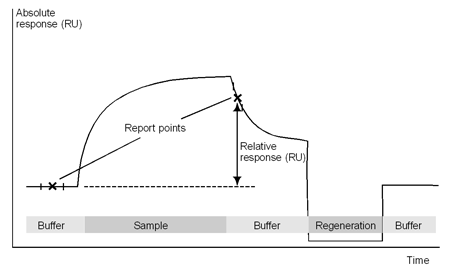
Schematic illustration of a sensorgram. The bars below the sensorgram curve indicate the solutions that pass over the sensor surface. - The sample matrix is the solution environment in which analyte is present in samples. This may be a simple well-defined solution such as a buffer, or a complex mixture such as a body fluid, cell extract or product formulation
The direct binding assay format is the most straightforward approach. The ligand is attached to the sensor chip surface, and binding of analyte is seen as a direct response.
Potential difficulties with the direct binding approach focus on problems in immobilizing the ligand with retained biological activity on the sensor surface, and problems in regenerating the surface without loss of activity. Both capturing and surface competition format provide alternatives in such cases
Direct binding assay
Direct binding assay with capture
Immobilization of ligand by capturing involves high affinity binding of the ligand to an immobilized capturing molecule. In general, the regeneration step in the assay procedure removes ligand along with any remaining bound analyte, so that new ligand needs to be captured for each assay cycle.
Capturing approaches can provide an alternative to covalent immobilization in situations where it is difficult to find chemical methods that give satisfactory results, or where the assay requires that the ligand on the surface can be changed. Capturing can also provide a ligand purification step, for example when tagged recombinant ligands are captured from partially purified material through binding of the tag to a specific capturing molecule.
The basic requirement for successful capturing is a robust high affinity interaction between the capturing molecule and the ligand. Monoclonal antibodies are frequently used as capturing agents. Even if the affinity is high, there will often be a certain amount of dissociation of the ligand from the surface during the course of an analysis. Since ligand is refreshed for each cycle, this can generally be ignored except for applications directed towards careful measurement of the kinetics of ligand-analyte binding.
Direct binding assay with capture
In the surface competition approach, a binding partner to the analyte is used as ligand, and a high molecular weight analogue to the analyte (typically analyte conjugated to a carrier protein) is added in constant amount to the samples to be measured. The basis of the assay is competition between analyte and the HMW analogue for binding to the ligand The measured response is the sum of the contributions from analyte and HMW molecule: as with the solution competition approach, the response is inversely related to the amount of analyte in the sample.
In Biacore contexts, surface competition assays generally rely on measurement of the rate of binding to the surface. In the same way as for direct binding assays, it is not necessary for the interaction of analyte or analogue with the surface to reach a steady state. This contrasts with inhibition assays, where the interaction of analyte with the detecting molecule in solution often reaches equilibrium before the sample is injected over the surface.
The surface competition approach can have advantages over the more common inhibition assay format in situations where immobilization of the analyte on the sensor chip surface presents problems. LMW analytes that are typically addressed with competition assays are not always amenable to the chemistry developed for attaching macromolecular ligands to the surface, and development of a suitable immobilization method for analyte which preserves the ability to bind detecting molecule can be a time-consuming process.
It can in many cases be simpler to develop a method for conjugating the analyte molecule to a carrier protein. The properties of the carrier protein are not important, provided that (a) it is large enough to give a response clearly distinguishable from that given by analyte alone, (b) it does not bind on its own to the sensor chip surface with attached ligand and (c) the conjugated analyte molecules are still available for binding to the ligand. The level of conjugation should be kept low (an average of one or less analyte molecules per carrier protein) to avoid avidity effects that arise from multiple ligand binding sites. This gives considerable freedom in the choice of carrier molecule: frequently a cheap and readily available protein like transferrin or haptoglobulin is fully adequate for the purpose. Avoid using serum albumin for this purpose since it binds to many small molecules.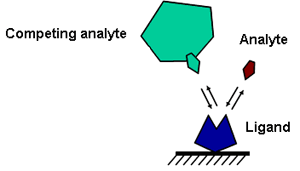
Surface competition assay
Surface competition assay with enhancement
The surface competition assay format may include an additional injection of enhancement reagent following the sample injection. This is typically an antibody or other macromolecule that binds specifically to the competing analyte, amplifying the response obtained. The enhancement format allows the use of relatively low molecular weight competing analytes that cannot be adequately distinguished in response levels from the lead compounds (e.g. a competing analyte tagged with biotin or other marker, enhanced with an antibody against the tag). The use of enhancement reagents may also help to improve the resolution of a surface competition assay, since the lead compounds with the strongest binding show the smallest response in this format.
Because the response in a surface competition assay with enhancement derives from binding of a macromolecule to the surface, solvent correction is unnecessary, and solvent correction cycles are not included in this assay format. Solvent correction may however be included if the enhancement step is omitted. Adaptivity is not available in surface competitions assays with or without enhancement.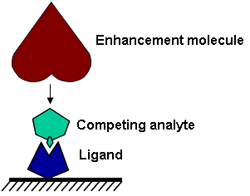
Surface competition assay with enhancement
Small molecule screening assays are based on two main strategies, along with some variations on these formats:
- Direct binding assay
The direct binding assay format is the most straightforward approach to screening, and is recommended as the method of choice for most purposes. Ligand covalently immobilized to chip surface or ligand captured by an immobilized capturing molecule - Surface competition assay
Single macromolecule analyte competition or enhancement molecule to amplify response of competing analyte
Panel 2 header
Lorem ipsum dolor sit amet, consectetur adipisicing elit. Repellendus aliquid tempore natus voluptates repudiandae, eos dolorem libero inventore, quod incidunt, asperiores. Reiciendis itaque enim pariatur, blanditiis minima autem quo a nulla, obcaecati quis, excepturi atque ab rerum! Sequi molestias vel eum, hic, perspiciatis eius suscipit reprehenderit molestiae vitae similique.
Panel 3 header
Lorem ipsum dolor sit amet, consectetur adipisicing elit. Repellendus aliquid tempore natus voluptates repudiandae, eos dolorem libero inventore, quod incidunt, asperiores. Reiciendis itaque enim pariatur, blanditiis minima autem quo a nulla, obcaecati quis, excepturi atque ab rerum! Sequi molestias vel eum, hic, perspiciatis eius suscipit reprehenderit molestiae vitae similique.

Panel 4 header
Lorem ipsum dolor sit amet, consectetur adipisicing elit. Repellendus aliquid tempore natus voluptates repudiandae, eos dolorem libero inventore, quod incidunt, asperiores. Reiciendis itaque enim pariatur, blanditiis minima autem quo a nulla, obcaecati quis, excepturi atque ab rerum! Sequi molestias vel eum, hic, perspiciatis eius suscipit reprehenderit molestiae vitae similique.
Panel 4 header 2
Lorem ipsum dolor sit amet, consectetur adipisicing elit. Repellendus aliquid tempore natus voluptates repudiandae, eos dolorem libero inventore, quod incidunt, asperiores. Reiciendis itaque enim pariatur, blanditiis minima autem quo a nulla, obcaecati quis, excepturi atque ab rerum! Sequi molestias vel eum, hic, perspiciatis eius suscipit reprehenderit molestiae vitae similique.
Panel 5 header
Lorem ipsum dolor sit amet, consectetur adipisicing elit. Repellendus aliquid tempore natus voluptates repudiandae, eos dolorem libero inventore, quod incidunt, asperiores. Reiciendis itaque enim pariatur, blanditiis minima autem quo a nulla, obcaecati quis, excepturi atque ab rerum! Sequi molestias vel eum, hic, perspiciatis eius suscipit reprehenderit molestiae vitae similique.
Panel 5 header 2
Lorem ipsum dolor sit amet, consectetur adipisicing elit. Repellendus aliquid tempore natus voluptates repudiandae, eos dolorem libero inventore, quod incidunt, asperiores. Reiciendis itaque enim pariatur, blanditiis minima autem quo a nulla, obcaecati quis, excepturi atque ab rerum! Sequi molestias vel eum, hic, perspiciatis eius suscipit reprehenderit molestiae vitae similique.
Panel 5 header 3
Lorem ipsum dolor sit amet, consectetur adipisicing elit. Repellendus aliquid tempore natus voluptates repudiandae, eos dolorem libero inventore, quod incidunt, asperiores. Reiciendis itaque enim pariatur, blanditiis minima autem quo a nulla, obcaecati quis, excepturi atque ab rerum! Sequi molestias vel eum, hic, perspiciatis eius suscipit reprehenderit molestiae vitae similique.
